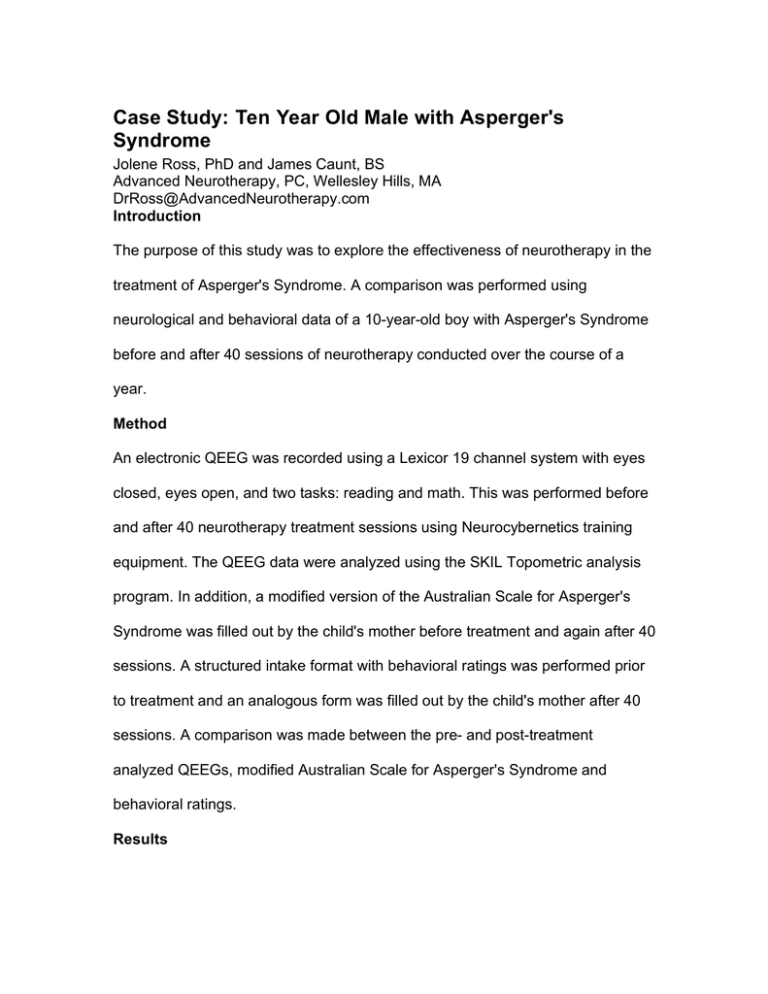Case Study: Ten Year Old Male with Asperger's Syndrome
advertisement

Case Study: Ten Year Old Male with Asperger's Syndrome Jolene Ross, PhD and James Caunt, BS Advanced Neurotherapy, PC, Wellesley Hills, MA DrRoss@AdvancedNeurotherapy.com Introduction The purpose of this study was to explore the effectiveness of neurotherapy in the treatment of Asperger's Syndrome. A comparison was performed using neurological and behavioral data of a 10-year-old boy with Asperger's Syndrome before and after 40 sessions of neurotherapy conducted over the course of a year. Method An electronic QEEG was recorded using a Lexicor 19 channel system with eyes closed, eyes open, and two tasks: reading and math. This was performed before and after 40 neurotherapy treatment sessions using Neurocybernetics training equipment. The QEEG data were analyzed using the SKIL Topometric analysis program. In addition, a modified version of the Australian Scale for Asperger's Syndrome was filled out by the child's mother before treatment and again after 40 sessions. A structured intake format with behavioral ratings was performed prior to treatment and an analogous form was filled out by the child's mother after 40 sessions. A comparison was made between the pre- and post-treatment analyzed QEEGs, modified Australian Scale for Asperger's Syndrome and behavioral ratings. Results After 40 sessions of neurotherapy the subject showed an approximate 2/3 improvement in behavioral http://www.isnr.org/2003/papers2003.htm (29 of 43)12/30/2006 5:48:22 AM 2003 ISNR - Scientific Presentations ratings. The posttreatment QEEG showed significant reductions in elevated 6-9 Hz slow wave activity in the medial and central-parietal regions with eyes open. There was also a dramatic reduction in the magnitude of elevated 9-12 Hz activity in the parietal and occipital regions with eyes open while reading and while performing math. Conclusion The subject, who was 11 years old at the time of reevaluation, experienced significant improvements in both neurological and behavioral functioning after 40 sessions of neurotherapy administered over the course of a year. A Comparison of QEEG Characteristics in Pediatric Asperger's Syndrome and Attention Deficit Disorder Jolene Ross, PhD and James Caunt, BS Advanced Neurotherapy, PC, Wellesley Hills, MA DrRoss@AdvancedNeurotherapy.com Introduction The purpose of this study was to evaluate the QEEG characteristics of seven children with Asperger's Syndrome and to compare them to seven children with Attention Deficit Disorder. Each group consisted of six males and one female ranging in age from five to fifteen years. Method Electronic QEEGs were recorded on each subject using a Lexicor 19 channel system during eyes closed, eyes open, and two tasks: reading and math. The data were analyzed using the SKIL Topometric Analysis Program. A comparison was made between the analyzed QEEG data from the Asperger's Syndrome and the Attention Deficit Disorder populations. Results The QEEGs of the Asperger's Syndrome subjects showed common functional features including: elevation of 4-7 Hz activity in the posterior regions, slowing at the vertex and regulatory dissociations between anterior and posterior regions of the cortex. In contrast, Attention Deficit Disorder subjects showed elevations of 47 Hz activity in the anterior and central regions, slowing at the vertex, and an absence of regulatory dissociations between the anterior and posterior regions of the cortex. Conclusion Although people with Asperger's Syndrome often present for treatment for symptoms associated with Attention Deficit Disorder, they show a marked difference in QEEG characteristics.







